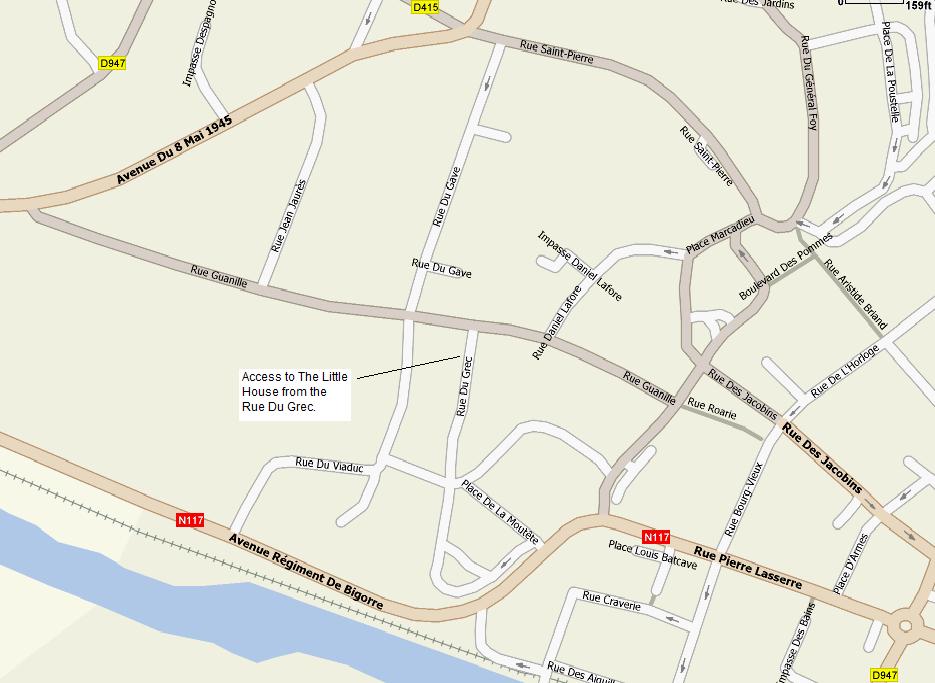Tourism Information
The
following
subjects are covered on this page :-
- Location Map
- Map of Orthez and location of The Little House
- Orthez - present day photographs
from around the town and potted history
- Orthez - the Battle of Orthez (i.e. the last one of the Peninsular War; Napoleon / Wellington)
General Location Map
Click on the map below to open it at a larger scale. If your cursor then shows a + sign, click again for a yet larger scale.Map of Orthez and location of The Little House
Click on the map below to see a bigger version of it. If your cursor then shows a + sign, click again for a yet larger image. 
As you may see on the map above, the peaceful market town of
Orthez has a railway line. This provides local services
as well as TGV direct to
Bordeaux and Paris. Access to the modern autoroute, La
Pyrénéenne, is at Junction 8 near Biron (approx. 5 km from The
Little House).
Click on the
map below to see a bigger version of it. If your
cursor then shows a + sign, click again for a yet larger
image.

The map above shows the main street layout of the centre of
Orthez. The Little House is approximately at the centre
of this map. A more precise location is shown on the map
below.

Parking and access to The Little House is from the Rue du Grec
but keys should be collected from 3 Rue du Viaduc.
Return to top of page
The Battle of Orthez
The last battle of the Peninsular War before the abdication of Napoleon was the Battle of Orthez, fought on 27 February 1814. (There was a later battle, near Toulouse, which was fought because news of the abdication had not reached). The French, over the preceding months, had been gradually forced to retreat from Portugal and Northern Spain into the Pays Basque and Béarn. The terrain from Orthez to the north and north west, rising from the Gave (river) de Pau, provided good defensive positions for the French under Marshal Soult. They had also demolished all the bridges across the river between Bayonne and Pau, except the Pont Vieux at Orthez, and were defending all the main locations where Wellington's troops might try to cross.Wellington tried to pin Soult’s centre - while one prong of his attack was into and through Orthez, the other attacked through and around St.Boes. While things did not go well initially, Wellington, committed his reserves and, by noon St.Boes had fallen and Major General Foy had been driven back.
The Pont Vieux (the old bridge) is said to be one of the most beautiful examples of mediaeval defensive architecture preserved to the present day, with its roofed tower (there were originally two) standing on the bridge itself. Although some repair of the parapets was required, it survived the defensive demolition attempt by the French forces and subsequently became the site of exchanges with Wellington's forces during the Battle of Orthez. (The Battle, 27 February 1814, was ultimately concluded on the rising ground just outside the town to the north and west. It was the final battle of the Peninsular War, although the Battle of Toulouse was fought after Napoleon had capitulated. The Napoleonic forces were put to flight, losing about 2600 of their troops killed or wounded, and another 1350 taken prisoner. The British / Portuguese allies lost perhaps 2300 killed and wounded).
If you are interested click here to go to our own, more complete, description of the battle.
A good link for further infoirmation is - http://www.balizetfr.com/battleoforthez.html but there are lots of others to be found by using appropriate search wording. For those who read French, a very informative site is http://www.orthez-1814.org/pertes_ang.htm
This says that the number of English officers killed or died of their wounds was 23.
Allied troops - various estimates of numbers, from different sources, ranging from 37,000 - 46,400
Napoleonic troops - estimates ranging from 30,000 - 44,500
